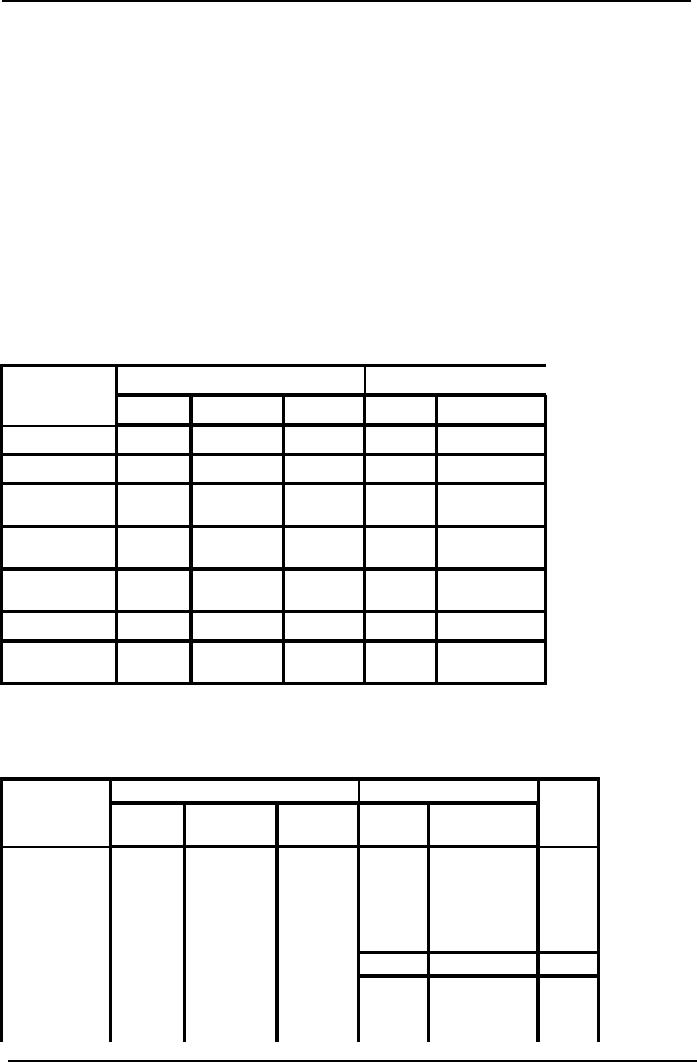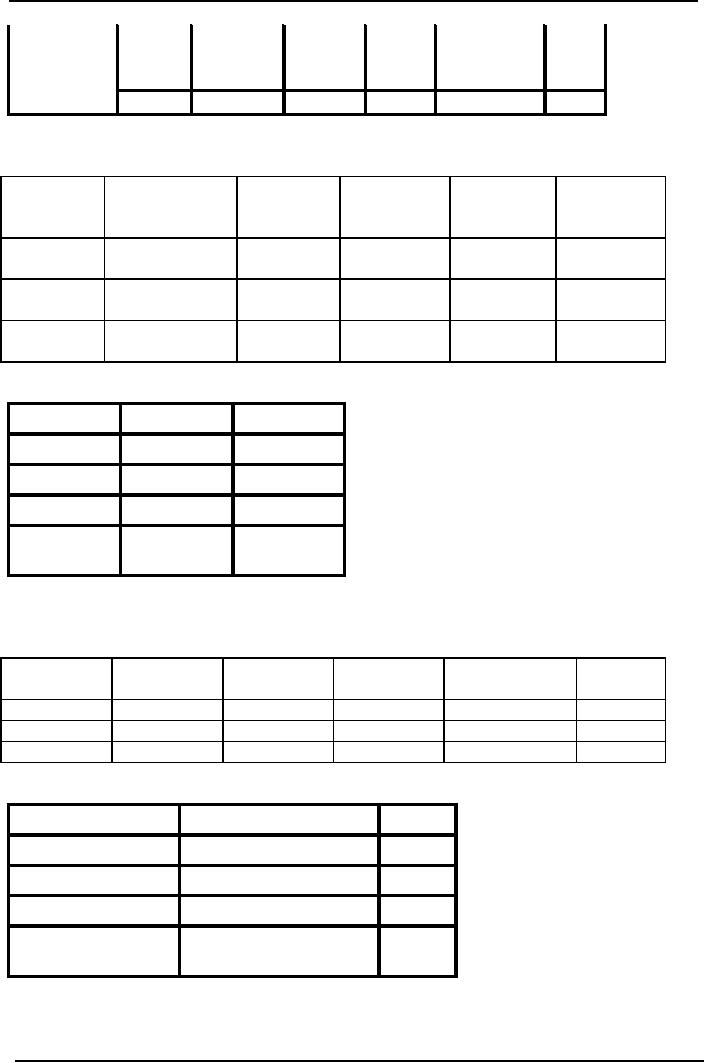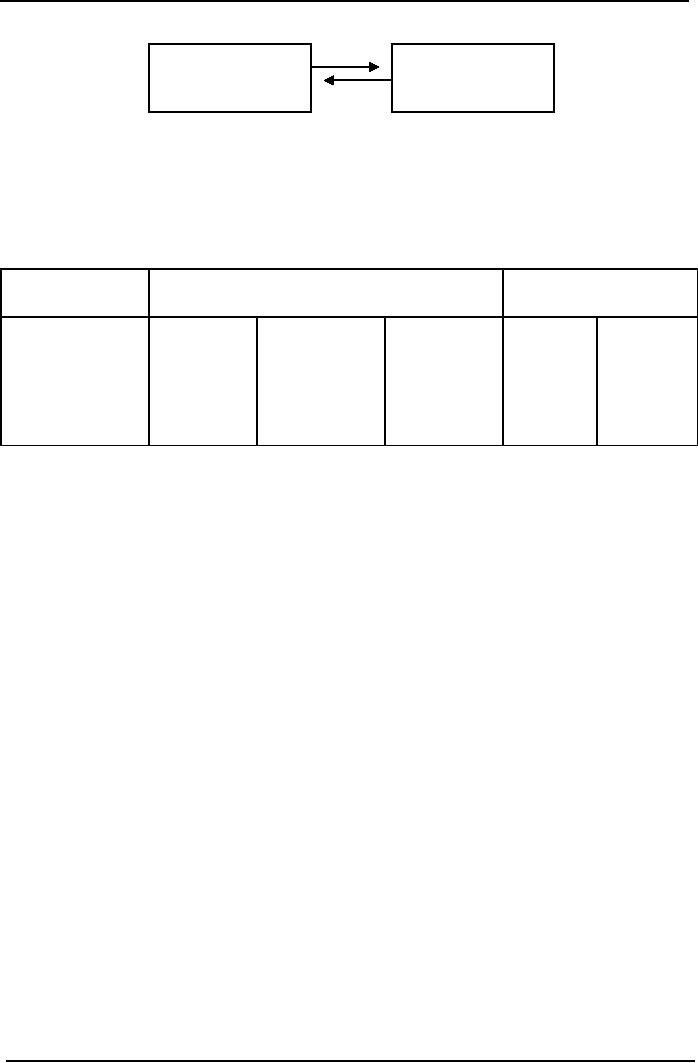 |
ALLOCATION AND APPORTIONMENT OF FOH COST |
| << LABOR TURNOVER AND LABOR EFFICIENCY RATIOS & FACTORY OVERHEAD COST |
| FACTORY OVERHEAD COST:Marketing, Research and development >> |

Cost
& Management Accounting
(MGT-402)
VU
LESSON
# 15
ALLOCATION
AND APPORTIONMENT OF FOH COST
Bases
for apportioning costs
In
selecting a basis for
apportioning an overhead item,
the cost of obtaining a high
degree of
accuracy
must be considered. For
example, the charge for
heat and light could be
shared on the
basis
of a complex formula incorporating
power points, light bulbs
and wattage but you
should be
aware
that the end result
will still be open to question. When
answering examination questions,
you
may
have to use your own
judgment in relation to the
information given as it is impracticable to
provide
a comprehensive list of bases to cover
every situation.
Practice
Question
Plastic
Pots & Furniture
Basis
of Apportionment
Production
Department
Service
Department
Molding
Machining Finishing Canteen
Maintenance
Materials
(Rs.)
300,000
130,000
45,000
40,000
75,000
Wages
(Rs.)
400,000
750,000
755,000
95,000
100,000
Cost
of Assets
125,000
250,000
130,000
70,000
75,000
(Rs.)
Horse
Power
700
1,400
600
88
200
Hour
Area
in Sq.
180
180
240
60
60
Yard
Metered
Units
6,000
6,000
7,000
2,000
3,000
No.
of
240
300
380
30
80
Employees
Plastic
Pots & Furniture
Work
Sheet
Apportionment
of Factory Overhead Product Department
Production
Department
Service
Department
Cost
Heads
Total
Machine
Molding
Machining Finishing
Canteen
Maintenance
Allocated
Cost
(Identified)
Materials
40,000
75,000
115,000
Labor
Wages
95,000
100,000
195,000
135,000
175,000
310,000
Electricity
13,500
13,500
15,750
4,500
6,750
54,000
Bonus
Pay
4,000
7,500
7,550
950
1,000
21,000
105

Cost
& Management Accounting
(MGT-402)
VU
Factory
Rent
60,000
60,000
80,000
20,000
20,000
240,000
Power
175,000
350,000
150,000
22,000
50,000
747,000
Depreciation
37,500
75,000
39,000
21,000
22,500
195,000
c/f
203,450
275,250
156,700
Apportionment
Electricity
Basis:
Metered units
Canteen
Machine
Molding
Machining
Finishing
Total
Maintenance
2,000
3,000
6,000
6,000
7,000
24,000
2
3
6
6
7
24
2/24
3/24
6/24
6/24
7/24
Molding
54,000x
6/24
13,500
Machining
54,000x
6/24
13,500
Finishing
54,000x
7/24
15,750
Canteen
54,000x
2/24
4,500
Machine
54,000x
3/24
6,750
maintenance
Apportionment
Bonus Pay
Basis:
Labor wages
Molding
Machining
Finishing
Canteen
Machine
Total
Maintenance
400,000
750,000
755,000
95,000
100,000
2,100,000
400
750
755
95
100
2100
400/2100
750/2100
755/2100
95/2100
100/2100
Molding
21,000/2100*400
4,000
Machining
21,000/2100*750
7,500
Finishing
21,000/2100*755
7,550
Canteen
21,000/2100*95
950
Machine
maintenance
21,000/2100*100
1,000
Reciprocal
costs between service
centers
A
particular problem arises
when service centers provide
reciprocal services to each
other
as in the following
figure.
106

Cost
& Management Accounting
(MGT-402)
VU
Maintenance
Payroll
Department
Section
In
this situation, a secondary
allocation of costs arises.
There are a number of methods of
dealing
with
this, of which the simplest,
the repeated distribution
method, is shown
below.
Repeated
distribution method
This
method takes each service
department in turn and
re-allocates its costs to all
departments
which
benefit. The re-allocation
continues until the numbers
being dealt with become
very small.
Problem
Question
Production
Service
Department
A
B
C
P
Q
Costs
Proportion
Rs.3,000
Rs.4,000
Rs.
2,000
Rs.2,500
Rs.2,700
P
Proportion Q
20
30
25
-
25
25
25
30
20
-
Apportion
the cost of Service
department to the Production departments.
To calculate the cost
of
a
cost unit we must include a
fair share of all costs
incurred in its production. If more
than one
product
is made. This will include
allocation and
apportionment.
Blanket
v departmental absorption
rates
Blanket
rates
A
blanket absorption rate is a
single rate of absorption
used throughout an organization's
production
facility and based upon its
total production costs and
activity.
The
use of a single blanket rate
makes the apportionment of
overhead costs unnecessary
since
the
total production costs are
to be used. How ever this is
not recommended for the
following
reasons:
�
It relies on a single activity
measure being appropriate for
the entire production
function.
�
It does not distinguish between
the miming costs of
particular activities or departments
when
absorbing costs into cost
units.
Departmental
rates
A
departmental absorption rate is a rate of
absorption based upon the
particular department's
overhead
cost and activity
level
This
method allows the activity of
each department to be measured using a
basis which is
appropriate.
It also ensures that the
cost attributed to the cost
unit reflects the cost of
the
departmental
resources used in its cost
units.
107
Table of Contents:
- COST CLASSIFICATION AND COST BEHAVIOR INTRODUCTION:COST CLASSIFICATION,
- IMPORTANT TERMINOLOGIES:Cost Center, Profit Centre, Differential Cost or Incremental cost
- FINANCIAL STATEMENTS:Inventory, Direct Material Consumed, Total Factory Cost
- FINANCIAL STATEMENTS:Adjustment in the Entire Production, Adjustment in the Income Statement
- PROBLEMS IN PREPARATION OF FINANCIAL STATEMENTS:Gross Profit Margin Rate, Net Profit Ratio
- MORE ABOUT PREPARATION OF FINANCIAL STATEMENTS:Conversion Cost
- MATERIAL:Inventory, Perpetual Inventory System, Weighted Average Method (W.Avg)
- CONTROL OVER MATERIAL:Order Level, Maximum Stock Level, Danger Level
- ECONOMIC ORDERING QUANTITY:EOQ Graph, PROBLEMS
- ACCOUNTING FOR LOSSES:Spoiled output, Accounting treatment, Inventory Turnover Ratio
- LABOR:Direct Labor Cost, Mechanical Methods, MAKING PAYMENTS TO EMPLOYEES
- PAYROLL AND INCENTIVES:Systems of Wages, Premium Plans
- PIECE RATE BASE PREMIUM PLANS:Suitability of Piece Rate System, GROUP BONUS SYSTEMS
- LABOR TURNOVER AND LABOR EFFICIENCY RATIOS & FACTORY OVERHEAD COST
- ALLOCATION AND APPORTIONMENT OF FOH COST
- FACTORY OVERHEAD COST:Marketing, Research and development
- FACTORY OVERHEAD COST:Spending Variance, Capacity/Volume Variance
- JOB ORDER COSTING SYSTEM:Direct Materials, Direct Labor, Factory Overhead
- PROCESS COSTING SYSTEM:Data Collection, Cost of Completed Output
- PROCESS COSTING SYSTEM:Cost of Production Report, Quantity Schedule
- PROCESS COSTING SYSTEM:Normal Loss at the End of Process
- PROCESS COSTING SYSTEM:PRACTICE QUESTION
- PROCESS COSTING SYSTEM:Partially-processed units, Equivalent units
- PROCESS COSTING SYSTEM:Weighted average method, Cost of Production Report
- COSTING/VALUATION OF JOINT AND BY PRODUCTS:Accounting for joint products
- COSTING/VALUATION OF JOINT AND BY PRODUCTS:Problems of common costs
- MARGINAL AND ABSORPTION COSTING:Contribution Margin, Marginal cost per unit
- MARGINAL AND ABSORPTION COSTING:Contribution and profit
- COST – VOLUME – PROFIT ANALYSIS:Contribution Margin Approach & CVP Analysis
- COST – VOLUME – PROFIT ANALYSIS:Target Contribution Margin
- BREAK EVEN ANALYSIS – MARGIN OF SAFETY:Margin of Safety (MOS), Using Budget profit
- BREAKEVEN ANALYSIS – CHARTS AND GRAPHS:Usefulness of charts
- WHAT IS A BUDGET?:Budgetary control, Making a Forecast, Preparing budgets
- Production & Sales Budget:Rolling budget, Sales budget
- Production & Sales Budget:Illustration 1, Production budget
- FLEXIBLE BUDGET:Capacity and volume, Theoretical Capacity
- FLEXIBLE BUDGET:ANALYSIS OF COST BEHAVIOR, Fixed Expenses
- TYPES OF BUDGET:Format of Cash Budget,
- Complex Cash Budget & Flexible Budget:Comparing actual with original budget
- FLEXIBLE & ZERO BASE BUDGETING:Efficiency Ratio, Performance budgeting
- DECISION MAKING IN MANAGEMENT ACCOUNTING:Spare capacity costs, Sunk cost
- DECISION MAKING:Size of fund, Income statement
- DECISION MAKING:Avoidable Costs, Non-Relevant Variable Costs, Absorbed Overhead
- DECISION MAKING CHOICE OF PRODUCT (PRODUCT MIX) DECISIONS
- DECISION MAKING CHOICE OF PRODUCT (PRODUCT MIX) DECISIONS:MAKE OR BUY DECISIONS